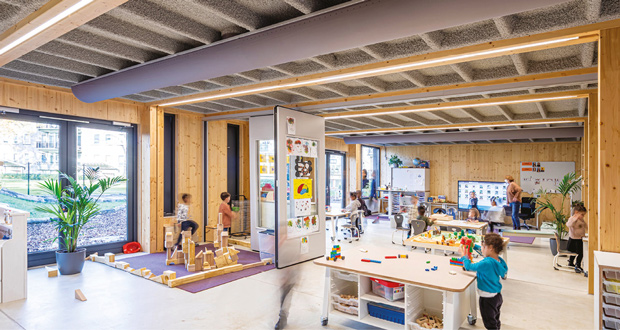 Martin Heaward, UK Head of Sales at Gewiss, explores why the industry must shift its focus beyond the fixture and towards holistic, future-ready solutions
Martin Heaward, UK Head of Sales at Gewiss, explores why the industry must shift its focus beyond the fixture and towards holistic, future-ready solutions
Whether in commercial offices, educational campuses, industrial facilities, or public sector estates, lighting decisions directly shape how effectively a space performs. Yet despite its broad impact, lighting procurement often remains rooted in a narrow, product-first approach that risks overlooking the bigger picture.
LIGHTING IMPACT
Research increasingly links lighting quality to occupant wellbeing and productivity. In offices, dynamic lighting schemes that mimic natural daylight can help reduce fatigue and improve focus. In educational establishments, proper lighting levels support concentration and reduce eye strain. And in industrial settings, good visibility can prevent accidents and improve output. From a facilities perspective, lighting also plays a pivotal role in energy management and operational efficiency. Poorly integrated or outdated systems can lead to wasted energy, high maintenance costs, and reduced lifecycle performance.
PURCHASING PROBLEMS
Many purchasing strategies are still focused on product availability, upfront cost, or historical preference. This approach can create significant long-term drawbacks. Systems may be poorly integrated, difficult to manage, or inflexible in the face of evolving operational needs.
A standardised approach may overlook the specific requirements of different spaces – the needs of an open-plan office differs greatly from those of meeting rooms, breakout areas, corridors, or kitchens. Similarly, in a warehouse environment, the lighting needs of high-bay storage areas differ significantly from those of packing stations, loading docks, or admin spaces. Applying a one-size-fits-all approach therefore risks compromising performance, comfort, and overall occupant experience.
INTEGRATED LIGHTING SOLUTIONS
FMs must treat lighting as part of a broader, integrated infrastructure. Modern lighting solutions can be connected with HVAC, security, and building management systems, enabling smarter, more efficient operations. Intelligent lighting controls, for example, allow energy use to be optimised according to occupancy patterns or natural daylight levels.
Future-ready lighting systems are:
Intelligent and connected: Centralised control platforms allow for monitoring, automation, and predictive maintenance.
Flexible and modular: Components can be upgraded or replaced with minimal disruption.
Energy-efficient: Advanced sensors and daylight-harvesting strategies reduce energy consumption.
User-centric: Controls and systems are tailored to the specific needs of each space, supporting occupant comfort and wellbeing.
Facilities managers who embed flexibility, intelligence, and sustainability into their lighting infrastructure can reduce lifecycle costs, improve operational resilience, and ensure that buildings remain functional and attractive for years to come.
PROPER PROCUREMENT
To ensure this it’s vital that facilities professionals consider their lighting strategies long before the procurement stage. Managers should engage lighting specialists early in the design or refurbishment process to ensure that systems are aligned with operational priorities, sustainability goals, and future requirements.
A trusted lighting partner provides much more than products – they deliver insight, technical expertise, and strategic guidance. They help identify opportunities to improve energy efficiency, optimise controls, and integrate lighting with other building systems. Crucially, they also support lifecycle management, ensuring systems remain effective, compliant, and upgradable as technologies evolve.
Lighting is no longer just a switch on the wall. It is a strategic asset that shapes occupant experience, drives energy efficiency, supports sustainability goals, and underpins operational resilience.The challenge is clear: move beyond product-first thinking and adopt a holistic, future-focused approach to lighting infrastructure. By engaging expert partners, integrating systems, and prioritising flexibility and intelligence, lighting can deliver far more than illumination – it can truly transform the way buildings perform – both now and in the future.





